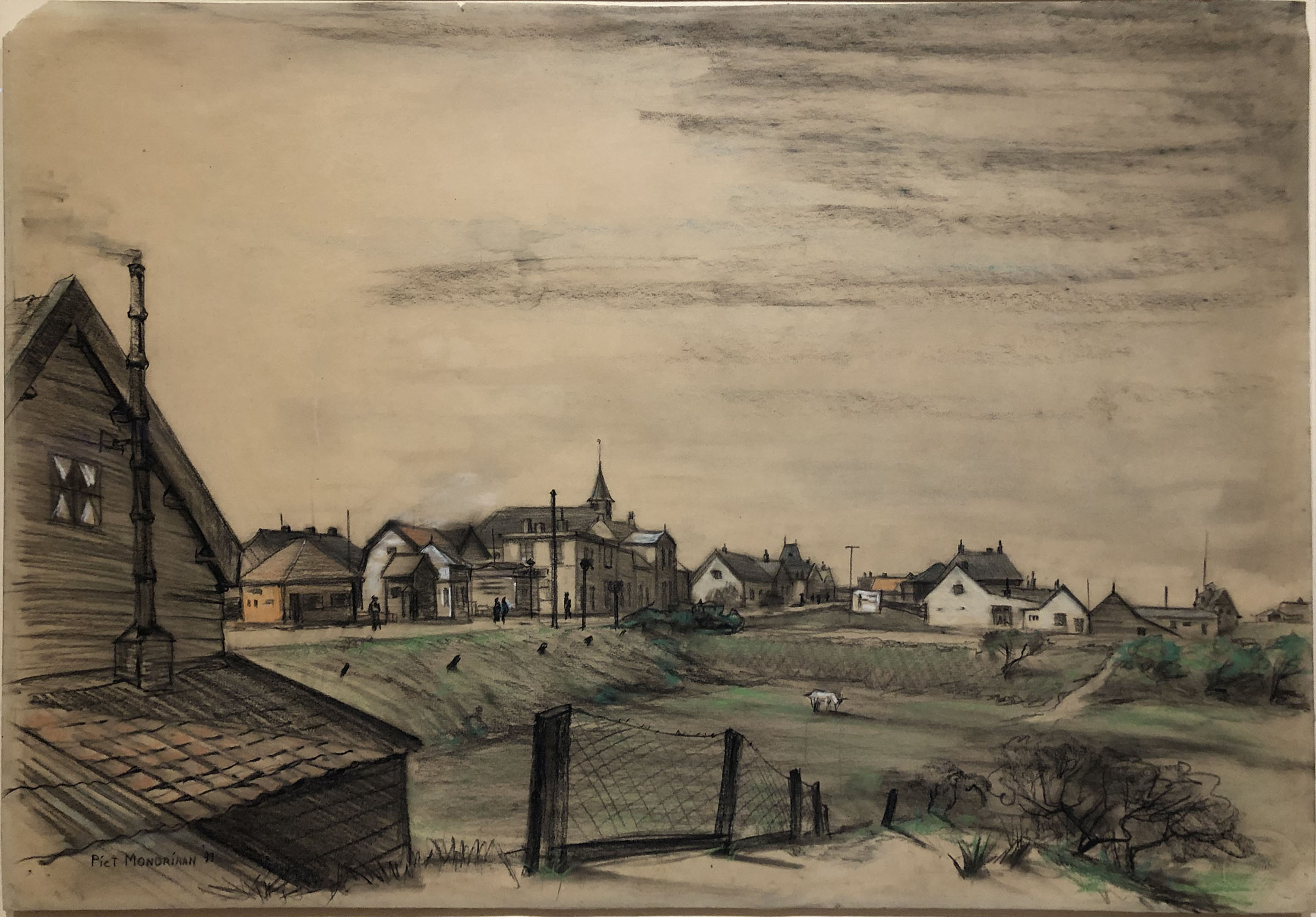 |
| Piet Mondrian, View Near the Weesperzijde, Tower of Blooker Chocolate Factory in the Distance, 1899. The Norton Simon Foundation |
Piet Mondrian is known primarily for the pristine abstractions of his maturity. In his native Holland, he is also renowned for Dutch landscapes and reductive flower pieces, some created simultaneously with the abstractions. Norton Simon bought one of Mondrian's early landscape pastels, and it's on view in the Pasadena museum's "All Consuming: Art and the Essence of Food."
Visitors who don't read the label won't likely know it's a Mondrian, nor how it relates to food. The connection is that it shows the Blooker chocolate factory, the building with the tower just left of center. The factory was considered a marvel of colonialist industrialism, but Mondrian seems to present it as an interloper in the Dutch landscape. The picture's main subject, to the extent it has one, is the polder, a low patch of agricultural land recovered by draining.
 |
| Blooker cacao poster from about 1900. The primary colors recall Mondrian's abstractions |
It may seem backwards to buy a Mondrian landscape rather than an abstraction. In fact Simon did acquire a important non-objective painting, Composition No. 10, in 1966. He sold it in 1982 (to Eugene Thaw), part of his all-consuming quest for a better deal.
"All Consuming: Art and the Essence of Food" runs through Aug. 14, 2023.
 |
| Piet Mondrian, Composition No. 10, 1939-1942. Private collection (formerly Norton Simon collection) |



Comments
John Walsh, former Director of the Getty Museum, delivered the lectures.
Walsh is a graduate of Yale College and returned to the area after his Getty tenure.
--- J. Garcin
Within a second of seeing this picture, I instantly thought it was a landscape of a Nazi death camp, rendered by a prisoner/artist. I went on the Norton Simon web site and saw the medium is pastel on paper. Most death-camp images were charcoal, I believe.
The Dutch know how to do austere. Just look at the piles of very drab-dark-palette paintings by Van Gogh from his early period at the Van Gogh Museum in Amsterdam.
My ears pricked up when I heard Norton Simon sold its Neo-Plastic Mondrian to Eugene Thaw. Go to the Met's web site and search "Eugene V. Thaw." He's the donor of hundreds and hundreds of paintings to the Met. Some are "halvsies." That is, co-owned, mainly by the Met and the Morgan.
Yes, I already checked. The Met doesn't own Thaw's 1966 Mondrian that the Norton Simon shed in 1982. But the Met does own a stunning Neo-Plastic Mondrian, his 1921 "Composition," thanks to the Jacques and Natasha Gelman Collection:
https://www.metmuseum.org/art/collection/search/490012
*
Re "Art and the Essence of Food": Rubens and the Philadelphia Museum are two rather circuitous topics that I need to discuss before getting to the most quintessential renderer of food and fauna in art history: Frans Snyders (Flemish (active Antwerp), 1579–1657).
Philadelphia has arguably the most important work by Peter Paul Rubens in North America: "Prometheus Bound," of 1611-1612, completed by 1618:
https://philamuseum.org/collection/object/104468
It is impossible to assess which is the greater artist of this work: Rubens, with his rendering of the tortured Prometheus; or Rubens's collaborator, Frans Snyders, who rendered the massive, merciless and torturing eagle.
Not to be outdone by Rubens's "Prometheus," Philadelphia has arguably the most important work by Snyders in North America: Still Life with Terms and a Bust of Ceres, c. 1630:
https://philamuseum.org/collection/object/104386
Snyders's gargantuan canvas is appropriately sized for a grand house. When the picture was not hanging on the walls, it was doing trompe l'oeil duty in front of the grand fireplace during spring and summer. It's near-grisaille background only makes the nuclear blast of fruits and birds in the foreground all the more real.
Snyders is mind blowing. Full stop. It is absolutely criminal that the Met does not have his work. It is some consolation, I suppose, that I can and do visit with Snyders when I go to the Frick: there is a majestic portrait of the artist, and a companion portrait of his wife, Margareta De Vos, both by Anthony Van Dyke, c. 1620:
https://collections.frick.org/objects/155/frans-snyders
https://collections.frick.org/objects/157/margareta-de-vos
Rubens's cartoons for the "Eucharist" tapestry series are at the Ringling. It's worth a journey to Sarasota, despite the failed state that is modern-day Florida.
As for some of the museums of SF, although that city has sometimes been described as America's Paris, they're not exactly of Paris-level quality or quantity. Regrettably, neither is LACMA---concrete overpass and all. But (along with Chris Burden's "Urban Light") maybe such a place (or SF's Golden Gate, etc) is good for selfie moments.